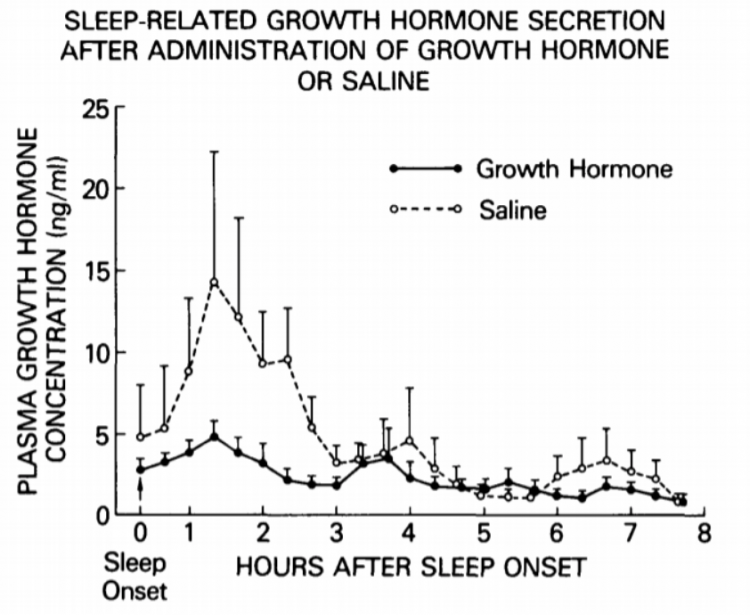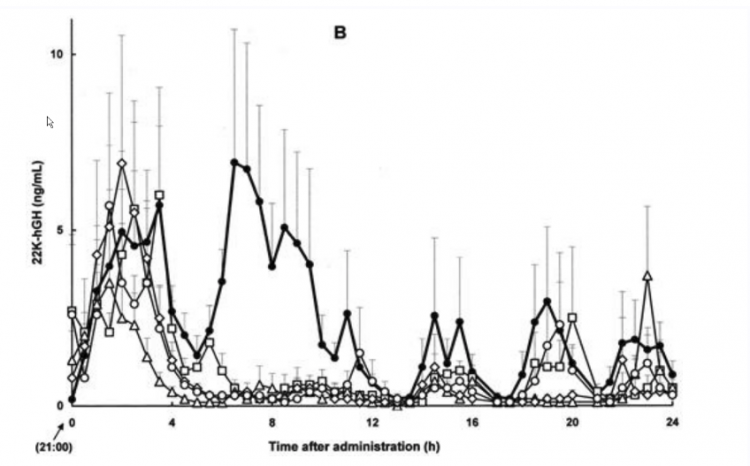
One of growth hormone’s more hallmark characteristics is its large sleep-related secretion, which occurs near the onset of slow wave (stage three) sleep [1-2]. This nighttime secretion accounts for nearly 70% of the entire daily GH secretory output in males. The nocturnal pulse is sexually dimorphic in nature, and significantly less pronounced in women [3-4].
Because this is such a substantial endogenous secretory event, individuals wanting to maximize their exogenous GH usage often speculate that a particular timing protocol may be used to protect this nocturnal secretion. The question remains, does this hypothesis have any merit?
As in all other endocrine systems, GH secretion is a target of multiple negative feedback loops and they are traditionally broken down into three categories: ultrashort, short, and long feedbacks [5]. The ultrashort feedback loop consists of growth hormone releasing hormone (GHRH) acutely inhibiting its own secretion as well as somatostatin (SRIF) suppressing its own release [6-8].
Short feedback loops consist of elevated serum GH levels acting directly upon the pituitary to inhibit further GH release via suppressed GHRH. In fact, elevated serum GH can also induce SRIF and GHRH inhibition within the hypothalamus. There does appear to be a bit of a time delay for the effect, as some trials have shown this particular feedback loop can take between two to four hours to set in [9-14]. This is also the specific feedback loop we are most concerned with as we attempt to answer the question here.
For completeness, the longest feedback loop occurs when elevated serum IGF-1 levels act upon the pituitary to decrease GH secretion events [15-16].
Fortunately for us, there have actually been two human trials which did a great job in helping to answer this question. The first took healthy male and female subjects and provided them with 2IUs/day of exogenous GH split into an AM (0800) and PM (1700) injection [17]. Despite the last GH being administered over six hours prior to sleep, the research team noticed a complete suppression of nocturnal endogenous secretions despite the elevated GH being long since cleared from the system. This would seemingly imply that another feedback mechanism beyond GH’s effects upon itself may be at work. See the figure at the end of the article for further information.
The second trial [18] took healthy male subjects and provided them with a single subcutaneous dose of 20kDa GH at 2100. The dose was varied and subjects were split into a 0.01, 0.025, 0.05, or 0.1 mg/kg dosing group. After a delay of a few hours, all dosing groups demonstrated a complete suppression of endogenous GH secretions for anywhere between 16-24 hours. In fact, taking out two outliers, the remaining subjects demonstrated complete suppression for the entire 24 hours monitored. It was interesting to see that one of the outliers was in the high dose group. You can see one of the charts from the trial at the end of the article.
Based on this, I think the real takeaway point here is that rHGH users should probably not hyper-focus on trying to keep the nocturnal pulse alive. It would seem that any significant exogenous rHGH dose is going to increase the likelihood it will be suppressed regardless. In fact, unless one is using GH strictly for lipolysis, the evening pulse is likely not going to provide an additive effect anyway simply due to how it is structured. Instead, I would urge folks to simply focus rather on the foundational dosing strategy guidelines described in my lipolysis and hypertrophy articles.


References
- Holl RW, Hartman ML, Veldhuis JD, Taylor WM, Thorner MO. Thirty-second sampling of plasma growth hormone in man: correlation with sleep stages. J Clin Endocrinol Metab. 1991 Apr;72(4):854-61
- Obal F Jr, Krueger JM. GHRH and sleep. Sleep Med Rev. 2004 Oct;8(5):367-77. Review
Van Cauter E, Plat L, Copinschi G. Interrelations between sleep and the somatotropic axis. Sleep. 1998 Sep 15;21(6):553-66. Review. - Jaffe CA, Ocampo-Lim B, Guo W, Krueger K, Sugahara I, DeMott-Friberg R, Bermann M, Barkan AL. Regulatory mechanisms of growth hormone secretion are sexually dimorphic. J Clin Invest. 1998 Jul 1;102(1):153-64.
- Farhy LS, Straume M, Johnson ML, Kovatchev B, Veldhuis JD. Unequal autonegative feedback by GH models the sexual dimorphism in GH secretory dynamics. Am J Physiol Regul Integr Comp Physiol. 2002 Mar;282(3):R753-64.
- Peterfreund RA, Vale WW. Somatostatin analogs inhibit somatostatin secretion from cultured hypothalamus cells. Neuroendocrinology. 1984 Nov;39(5):397-402.
- Lumpkin MD, McDonald JK. Blockade of growth hormone-releasing factor (GRF) activity in the pituitary and hypothalamus of the conscious rat with a peptidic GRF antagonist. Endocrinology. 1989 Mar;124(3):1522-31.
- Lumpkin MD, Mulroney SE, Haramati A. Inhibition of pulsatile growth hormone (GH) secretion and somatic growth in immature rats with a synthetic GH-releasing factor antagonist. Endocrinology. 1989 Mar;124(3):1154-9.
- Berelowitz M, Firestone SL, Frohman LA. Effects of growth hormone excess and deficiency on hypothalamic somatostatin content and release and on tissue somatostatin distribution. Endocrinology. 1981 Sep;109(3):714-9.
- Chomczynski P, Downs TR, Frohman LA. Feedback regulation of growth hormone (GH)-releasing hormone gene expression by GH in rat hypothalamus. Mol Endocrinol. 1988 Mar;2(3):236-41
- Frohman MA, Downs TR, Chomczynski P, Frohman LA. Cloning and characterization of mouse growth hormone-releasing hormone (GRH) complementary DNA: increased GRH messenger RNA levels in the growth hormone-deficient lit/lit mouse. Mol Endocrinol. 1989 Oct;3(10):1529-36.
- Rosenthal SM, Kaplan SL, Grumbach MM. Short term continuous intravenous infusion of growth hormone (GH) inhibits GH-releasing hormone-induced GH secretion: a time-dependent effect. J Clin Endocrinol Metab. 1989 Jun;68(6):1101-5.
- Yamauchi N, Shibasaki T, Ling N, Demura H. In vitro release of growth hormone-releasing factor (GRF) from the hypothalamus: somatostatin inhibits GRF release. Regul Pept. 1991 Mar 26;33(1):71-8.
- Pontiroli AE, Lanzi R, Monti LD, Sandoli E, Pozza G. Growth hormone (GH) autofeedback on GH response to GH-releasing hormone. Role of free fatty acids and somatostatin. J Clin Endocrinol Metab. 1991 Feb;72(2):492-5.
- Müller EE. Clinical implications of growth hormone feedback mechanisms. Horm Res. 1990;33 Suppl 4:90-6. Review.
- Bermann M, Jaffe CA, Tsai W, DeMott-Friberg R, Barkan AL. Negative feedback regulation of pulsatile growth hormone secretion by insulin-like growth factor I. Involvement of hypothalamic somatostatin. J Clin Invest. 1994 Jul;94(1):138-45.
- Mendelson WB, Jacobs LS, Gillin JC. Negative feedback suppression of sleep-related growth hormone secretion. J Clin Endocrinol Metab. 1983 Mar;56(3):486-8.
- Hashimoto Y, Kamioka T, Hosaka M, Mabuchi K, Mizuchi A, Shimazaki Y, Tsunoo M, Tanaka T. Exogenous 20K growth hormone (GH) suppresses endogenous 22K GH secretion in normal men. J Clin Endocrinol Metab. 2000 Feb;85(2):601-6.
About the author
Chester “Chest” Rockwell is head coach of TeamStackingPlates (TSP). For more information on the team, coaching inquiries, as well as more articles, please visit the team website.
